10 body positions we should all find relaxing
The following body positions most kids can relax in easily, but as adults we may stop being able to do them if we allow our muscles to shorten. That lack of flexibility impairs our ability to move properly making us more prone to injury. So if “relaxing” is not the word you would use to describe these positions, working towards being able to do them easily again may just change your life.
Here are my initial ideas on positions I think we should be able to do throughout our life. Do these in bare feet for best results, and keep any stretch mild.
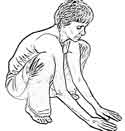
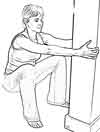 1. Squat to the Floor We should be able to easily spend time in a deep squat keeping our heels down without falling backwards, body leaning between the legs as if we were pooping in the woods. If you cannot do this, try holding onto a sturdy post and lower yourself down leaning back just enough to keep your heels on the floor. You can always sit on a low step-stool for extra support and to make the position more relaxing. Keep your knees in line with your toes, ease into a stretch and wait for it to dissipate. In addition to pushing through your feet you can use your arms to help pull you up when you are done. (Please note: NEVER do a squat to the floor with added weight. Avoid if you have a disk problem in your back.)
1. Squat to the Floor We should be able to easily spend time in a deep squat keeping our heels down without falling backwards, body leaning between the legs as if we were pooping in the woods. If you cannot do this, try holding onto a sturdy post and lower yourself down leaning back just enough to keep your heels on the floor. You can always sit on a low step-stool for extra support and to make the position more relaxing. Keep your knees in line with your toes, ease into a stretch and wait for it to dissipate. In addition to pushing through your feet you can use your arms to help pull you up when you are done. (Please note: NEVER do a squat to the floor with added weight. Avoid if you have a disk problem in your back.)

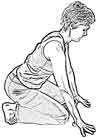 2. Tripod Split Squat From the squat position above, drop one knee to the floor and sit on the heel of that foot. This position is comfortable and stable as you have created a triangle on the ground with the points being one knee, the toes of the same leg and the other foot. Make sure you switch sides to work on both legs. This is the ideal position for lifting heavy objects off the floor as one can straddle the object being lifted thereby keeping it close to our body, the spine has a neutral curve, and it forces the use of the legs rather than the back to get up. But it requires good toe flexibility which is usually the limiting factor in this position. If this is too painful, work on your toe flexibility by going onto all 4s, tucking your toes under and leaning back until you can sit on your heels. Toe spreaders can also be very helpful.
2. Tripod Split Squat From the squat position above, drop one knee to the floor and sit on the heel of that foot. This position is comfortable and stable as you have created a triangle on the ground with the points being one knee, the toes of the same leg and the other foot. Make sure you switch sides to work on both legs. This is the ideal position for lifting heavy objects off the floor as one can straddle the object being lifted thereby keeping it close to our body, the spine has a neutral curve, and it forces the use of the legs rather than the back to get up. But it requires good toe flexibility which is usually the limiting factor in this position. If this is too painful, work on your toe flexibility by going onto all 4s, tucking your toes under and leaning back until you can sit on your heels. Toe spreaders can also be very helpful.
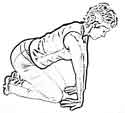
 3. Kneeling Come down onto all fours, tops of the feet down, but turn your hands around so the fingers are pointing back at your knees, palms down. Gently lean back to get a mild stretch in the forearms. When this range of motion is lost we lose the ability to weight-bear through our hands. When you have had enough of that, take the hands off the floor and sit down fully on your ankles and heels to stretch out the tops of the feet and front of the lower legs. If you can't sit all the way back, put your hands on the floor and lean back as much as you need to get a stretch. Once you can sit comfortably like this on the floor, you will be able to interact much more easily with babies and toddlers. Also being able to get up and down from the floor easily will keep your legs stronger than they otherwise would be.
3. Kneeling Come down onto all fours, tops of the feet down, but turn your hands around so the fingers are pointing back at your knees, palms down. Gently lean back to get a mild stretch in the forearms. When this range of motion is lost we lose the ability to weight-bear through our hands. When you have had enough of that, take the hands off the floor and sit down fully on your ankles and heels to stretch out the tops of the feet and front of the lower legs. If you can't sit all the way back, put your hands on the floor and lean back as much as you need to get a stretch. Once you can sit comfortably like this on the floor, you will be able to interact much more easily with babies and toddlers. Also being able to get up and down from the floor easily will keep your legs stronger than they otherwise would be.
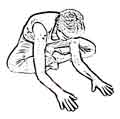
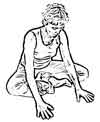 4. Cross-legged sit with forward bend Sit down on the floor and bring one heel into your perineum, and the other heel just in front of that foot. Your knees should be wide and your legs should feel relaxed. If not, try sitting on a phone book or pillow so that your knees are lower than your pelvis. Now lean forward and if possible, rest your elbows and forearms on the floor in front of you, keeping your sit bones down. If not possible, rest your hands on the floor. Avoid the temptation to look up, which would shorten the back of the neck. Most likely you will feel a stretch in the hip of the forward leg, and possibly the inner thighs and low back. Switch the feet to keep the other hip limber too. (Avoid bending forward if you have a disk problem.)
4. Cross-legged sit with forward bend Sit down on the floor and bring one heel into your perineum, and the other heel just in front of that foot. Your knees should be wide and your legs should feel relaxed. If not, try sitting on a phone book or pillow so that your knees are lower than your pelvis. Now lean forward and if possible, rest your elbows and forearms on the floor in front of you, keeping your sit bones down. If not possible, rest your hands on the floor. Avoid the temptation to look up, which would shorten the back of the neck. Most likely you will feel a stretch in the hip of the forward leg, and possibly the inner thighs and low back. Switch the feet to keep the other hip limber too. (Avoid bending forward if you have a disk problem.)
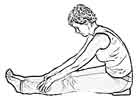 5. Seated forward fold Sit tall on your sit bones on the floor with your legs stretched out in front of you. If possible, gently fold forward keeping the knees soft and collar bones wide, until you feel a mild stretch in the back of your legs. Some people are able to relax with their chest on their thighs, while many of us may not be able to fold forward at all. If you are sitting behind your sit bones, sit on a phone book or pillow to raise you enough to make it possible for you to relax on your sit bones. Sitting on a block with your back against a wall to provide some support may be a very good starting point as one can easily relax and spend time in that position. (If you have a disk problem you need hamstring stretching, but this is not the best choice for you. See a physio, CHEK Practitioner or personal trainer who can teach you a hamstring stretch that keeps your spine in neutral.)
5. Seated forward fold Sit tall on your sit bones on the floor with your legs stretched out in front of you. If possible, gently fold forward keeping the knees soft and collar bones wide, until you feel a mild stretch in the back of your legs. Some people are able to relax with their chest on their thighs, while many of us may not be able to fold forward at all. If you are sitting behind your sit bones, sit on a phone book or pillow to raise you enough to make it possible for you to relax on your sit bones. Sitting on a block with your back against a wall to provide some support may be a very good starting point as one can easily relax and spend time in that position. (If you have a disk problem you need hamstring stretching, but this is not the best choice for you. See a physio, CHEK Practitioner or personal trainer who can teach you a hamstring stretch that keeps your spine in neutral.)
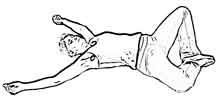 6. Supine butterfly with T-Y-I relax Lie on the floor on your back and lean the soles of your feet into each other, heels close to the perineum, possibly creating a stretch in your inner thighs. If the stretch is too great for the inner thighs, play with the distance your heels are from your perineum, or use pillows for support under your knees. If your head is tilted back to reach the floor, use a pillow so you can keep the plane of your face horizontal. Hopefully eventually you won't need the pillow. Rest your arms out to the side like the letter T, raising them up as high as you can while keeping them on the floor. Perhaps you will be forming the letter Y with your arms and trunk. The goal is to eventually have your upper arms up against your ears like the letter I, yet relaxed on the floor and feeling no stretch in your chest or armpits.
6. Supine butterfly with T-Y-I relax Lie on the floor on your back and lean the soles of your feet into each other, heels close to the perineum, possibly creating a stretch in your inner thighs. If the stretch is too great for the inner thighs, play with the distance your heels are from your perineum, or use pillows for support under your knees. If your head is tilted back to reach the floor, use a pillow so you can keep the plane of your face horizontal. Hopefully eventually you won't need the pillow. Rest your arms out to the side like the letter T, raising them up as high as you can while keeping them on the floor. Perhaps you will be forming the letter Y with your arms and trunk. The goal is to eventually have your upper arms up against your ears like the letter I, yet relaxed on the floor and feeling no stretch in your chest or armpits.
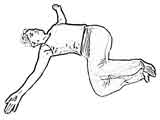 7. Supine torso twist Lie on your back with your arms out to the side, knees bent, feet on the floor. Push through the feet to lift the pelvis up, and place it on the floor slightly to the left. Drop the knees to the right towards the floor, keeping the shoulder-blades down, possibly feeling a stretch in the left side and buttock. Ideally you should be able to relax with the legs on the floor in this deep twist. If you cannot, put pillows under your legs to support them so that you can relax, but still feel a stretch. Do the other side as well.
7. Supine torso twist Lie on your back with your arms out to the side, knees bent, feet on the floor. Push through the feet to lift the pelvis up, and place it on the floor slightly to the left. Drop the knees to the right towards the floor, keeping the shoulder-blades down, possibly feeling a stretch in the left side and buttock. Ideally you should be able to relax with the legs on the floor in this deep twist. If you cannot, put pillows under your legs to support them so that you can relax, but still feel a stretch. Do the other side as well.
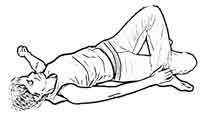 8. Ankle across knee torso twist Lie on your back with your arms out to the side, right knee bent, foot on the floor, left ankle resting on the right thigh so the left knee is pointing out to the side. Slowly drop the right knee down to the right side so that the left foot ends up on the floor and you can hang onto it with your right hand. The left knee should just hang away from the body. You may feel a stretch in the front or side of the left hip. Use pillows for support if needed. Do the other side.
8. Ankle across knee torso twist Lie on your back with your arms out to the side, right knee bent, foot on the floor, left ankle resting on the right thigh so the left knee is pointing out to the side. Slowly drop the right knee down to the right side so that the left foot ends up on the floor and you can hang onto it with your right hand. The left knee should just hang away from the body. You may feel a stretch in the front or side of the left hip. Use pillows for support if needed. Do the other side.
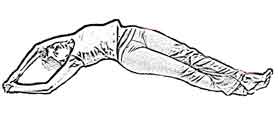 9. Supine C stretch Lie on your back with your legs stretched out, and your hands clasped overhead. Move your legs and arms to the same side so you are taking the shape of a banana, but do not allow your pelvis to rotate. Cross the foot of the leg that is on the outside side of the curve over the foot of the inside leg, relax and feel a gentle stretch through the lateral line of of the body. If you feel any discomfort in your pelvis, try holding in your pelvic floor as if you were stopping the flow of urine and draw in the tissue just above the pubis. Notice any differences side to side.
9. Supine C stretch Lie on your back with your legs stretched out, and your hands clasped overhead. Move your legs and arms to the same side so you are taking the shape of a banana, but do not allow your pelvis to rotate. Cross the foot of the leg that is on the outside side of the curve over the foot of the inside leg, relax and feel a gentle stretch through the lateral line of of the body. If you feel any discomfort in your pelvis, try holding in your pelvic floor as if you were stopping the flow of urine and draw in the tissue just above the pubis. Notice any differences side to side.
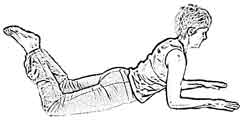 10. Sphinx with lower legs up Lie on your belly and come up onto your elbows, forearms and hands facing forward, elbows at 90 degrees, while keeping your pelvis on the floor. Keep the back of the neck long, chin drawing into the front of the neck slightly. Try to arch your upper back by keeping the collar bones wide, lifting your sternum up and through your arms and feeling a stretch in the belly. If this is comfortable for your low back, try bending your knees so the flats of your feet are facing the ceiling. This position should be quite restful, but if your low back is bothering you, only come up as high as is comfortable, and try supporting your pelvis by drawing in the tissue just above the pubis. For some, lying on the floor with the forehead on the hands may be all that can be initially tolerated. Find the position you can relax in and progress from there.
10. Sphinx with lower legs up Lie on your belly and come up onto your elbows, forearms and hands facing forward, elbows at 90 degrees, while keeping your pelvis on the floor. Keep the back of the neck long, chin drawing into the front of the neck slightly. Try to arch your upper back by keeping the collar bones wide, lifting your sternum up and through your arms and feeling a stretch in the belly. If this is comfortable for your low back, try bending your knees so the flats of your feet are facing the ceiling. This position should be quite restful, but if your low back is bothering you, only come up as high as is comfortable, and try supporting your pelvis by drawing in the tissue just above the pubis. For some, lying on the floor with the forehead on the hands may be all that can be initially tolerated. Find the position you can relax in and progress from there.
If you want to subscribe or search for other posts by title or by topic, go to www.wellnesstips.ca.
Related Tips
Foot flexibility important to reducing hip and SI joint pain
S-t-r-e-t-c-h and feel better!
Copyright 2010 Vreni Gurd
 Facebook Wellness-Tips Page
Facebook Wellness-Tips Page
suzanne jaffe stillman said,
September 11, 2011 @ 11:25 am
Thanks for all this wonderful information and especially your article on flexablity vs. strength.
In reviewing the 10 above there are ones I cannot do due to a total hip relplacement. Maybe at some time you can address positions for those who have had knee replacements and or hip replacements. If so please put me on your list.
I still cannot beleive that there is not s CHEK practitioner in Los Angeles CA.
Thanks for all the information.
Suzanne
Vreni said,
September 11, 2011 @ 3:41 pm
Hi Suzanne,
As far as I understand, internal rotation is the biggest issue with hip replacements, and needs to be avoided. So of the above stretches, the only one that might not be suitable is the supine torso twist. All the other stretches, the hip is either in external rotation or in flexion or extension which should not pose a problem.
All the same, worth asking your doctor.
Obviously I’m showing the end goal here. But one needs to start where one can and over time (months to years) of daily practice, flexibility can improve greatly. Remember to keep the stretch very gentle at all times – only a 2 out of 10 – and wait for the stretch to dissipate. If it hurts, you are not helping yourself.
Hope that helps.
how to start a business from scratch said,
June 7, 2012 @ 12:12 am
We enjoyed most of this valuable read, thanks.
Connie said,
November 25, 2012 @ 9:22 pm
I have become a tin man! At 55 and a former gymnast I can only do 5 of these stretches. Some of them are almost impossible for me to attempt with my OA knees. Is it still useful to try? I still am very active but move with such restrictions can this be reversed?
Thanks
Vreni said,
November 26, 2012 @ 12:15 pm
Hi Connie,
Maybe go very very slow, and hold the position as soon as you feel the first signs of tension and before pain? If you can keep working diligently around the edge of your abilities hopefully the range of motion will slowly increase. At the least, maybe you can protect the range you’ve got. You might find you are more able when warm?
I’d also suggest drinking lots and lots of water, as cartilage is built from the bone out. If one is dehydrated, water is taken from cartilage and other non-essential areas to keep the blood the right consistency. Hopefully if you remain hydrated enough you can build cartilage faster than it wears away.
The more range of motion you have the less compression going through the joints, which I would think would help.
Vreni